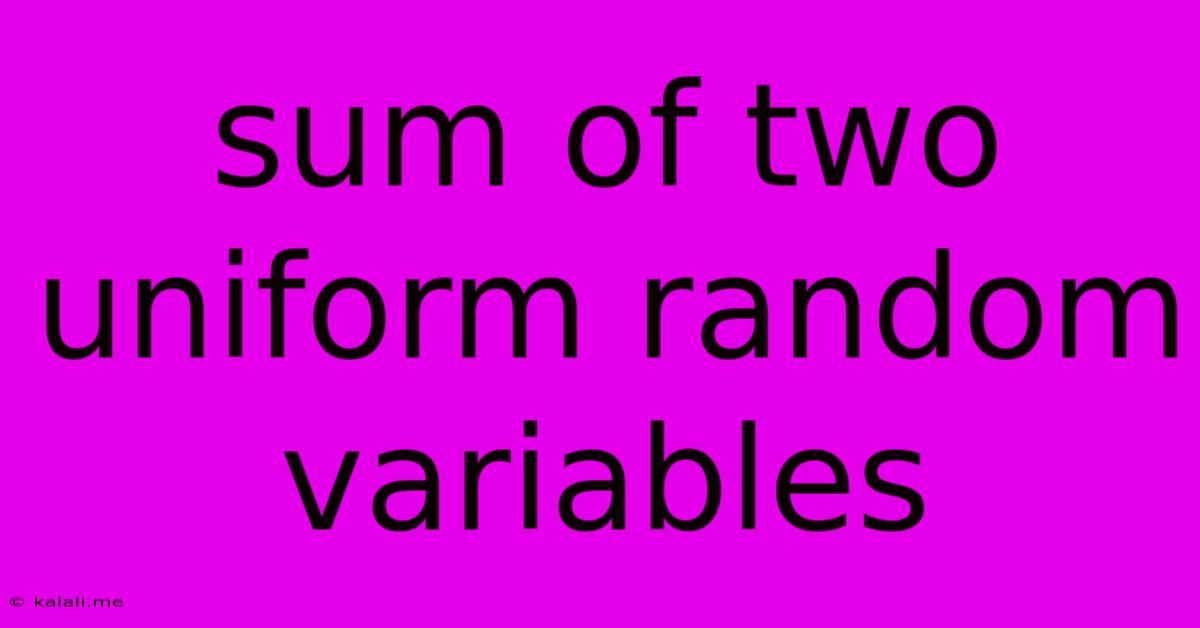Sum Of Two Uniform Random Variables
Kalali
Jun 01, 2025 · 3 min read

Table of Contents
The Sum of Two Uniform Random Variables: A Comprehensive Guide
Meta Description: Understanding the distribution of the sum of two uniform random variables is crucial in probability and statistics. This guide provides a detailed explanation, covering calculations, examples, and real-world applications.
The sum of two independent uniform random variables is a common problem encountered in probability and statistics. Understanding its distribution is fundamental for various applications, from modeling waiting times to analyzing error accumulation in systems. This article will delve into the intricacies of this topic, exploring both the mathematical derivation and practical implications.
Understanding Uniform Random Variables
Before diving into the sum, let's clarify what a uniform random variable is. A uniform random variable, often denoted as U(a, b), is a continuous random variable where the probability of the variable taking on a value within a given interval is constant. In simpler terms, any value within the interval [a, b] has an equal chance of being selected. The probability density function (PDF) for a uniform random variable is:
f(x) = 1/(b-a) for a ≤ x ≤ b f(x) = 0 otherwise
Deriving the Distribution of the Sum
Let's consider two independent uniform random variables, X ~ U(0, 1) and Y ~ U(0, 1). We want to find the probability distribution of Z = X + Y. There are several ways to approach this, but one common method involves using convolution.
The convolution of two probability density functions, f<sub>X</sub>(x) and f<sub>Y</sub>(y), is defined as:
f<sub>Z</sub>(z) = ∫f<sub>X</sub>(x)f<sub>Y</sub>(z-x)dx
Applying this to our uniform random variables:
f<sub>Z</sub>(z) = ∫<sub>0</sub><sup>1</sup> 1 * 1 dx for 0 ≤ z ≤ 1 f<sub>Z</sub>(z) = ∫<sub>z-1</sub><sup>1</sup> 1 * 1 dx for 1 ≤ z ≤ 2 f<sub>Z</sub>(z) = 0 otherwise
Solving these integrals, we get the PDF of Z:
f<sub>Z</sub>(z) = z for 0 ≤ z ≤ 1 f<sub>Z</sub>(z) = 2 - z for 1 ≤ z ≤ 2 f<sub>Z</sub>(z) = 0 otherwise
This results in a triangular distribution. Notice that the probability density is not uniform; it's highest at z = 1 and decreases linearly towards 0 and 2.
Generalization to U(a, b)
The above derivation was for U(0, 1) variables. To generalize this to U(a, b) variables, we can use a simple linear transformation. If X ~ U(a, b) and Y ~ U(a, b), then Z = X + Y will have a more complex triangular distribution with bounds between 2a and 2b. The exact formula will involve scaling and shifting the triangular distribution obtained previously.
Real-World Applications
The sum of uniform random variables has applications in various fields:
- Simulation: Simulating the sum of errors in measurement systems.
- Queueing Theory: Modeling waiting times in systems with multiple independent arrival processes.
- Image Processing: Analyzing pixel intensities in images.
- Financial Modeling: Simulating the sum of multiple independent returns.
Conclusion
Understanding the distribution of the sum of two uniform random variables provides a valuable tool for probability and statistics. While the derivation might seem complex at first, the resulting triangular distribution offers a simple yet powerful model for numerous real-world phenomena. Remember to adjust the calculations based on the specific range of your uniform variables. Further exploration can involve analyzing the sum of more than two uniform random variables, leading to increasingly complex, yet fascinating, distributions.
Latest Posts
Latest Posts
-
How Far Can I Drive Without A Coolant Reservoir
Jun 03, 2025
-
Brompton Pump Mounting Problems Bolts Too Short
Jun 03, 2025
-
How To Put In Closet Doors
Jun 03, 2025
-
Water Coming Out Of My Tailpipe
Jun 03, 2025
-
Can You Track A Visa Gift Card
Jun 03, 2025
Related Post
Thank you for visiting our website which covers about Sum Of Two Uniform Random Variables . We hope the information provided has been useful to you. Feel free to contact us if you have any questions or need further assistance. See you next time and don't miss to bookmark.